Financial Accounting Assignment Solution, UGB105 Module
VerifiedAdded on 2023/01/09
|13
|3265
|61
Homework Assignment
AI Summary
This assignment solution provides a detailed analysis of financial accounting principles and practices. It begins with the preparation of Bob's trading account, profit and loss account, and statement of financial position, including calculations and interpretations. The solution then critically evaluates the main features of financial information for users, emphasizing relevance, reliability, timeliness, and understandability. It also demonstrates the importance of financial information for various stakeholders, including management, investors, employees, and shareholders. The assignment further includes the calculation and interpretation of key financial ratios, such as gross profit margin, return on capital employed, current ratio, trade payable period, and trade receivable period. Finally, it provides a balanced bank account for March. The assignment covers a wide range of topics, offering comprehensive insights into financial accounting.

Financial Accounting
Paraphrase This Document
Need a fresh take? Get an instant paraphrase of this document with our AI Paraphraser
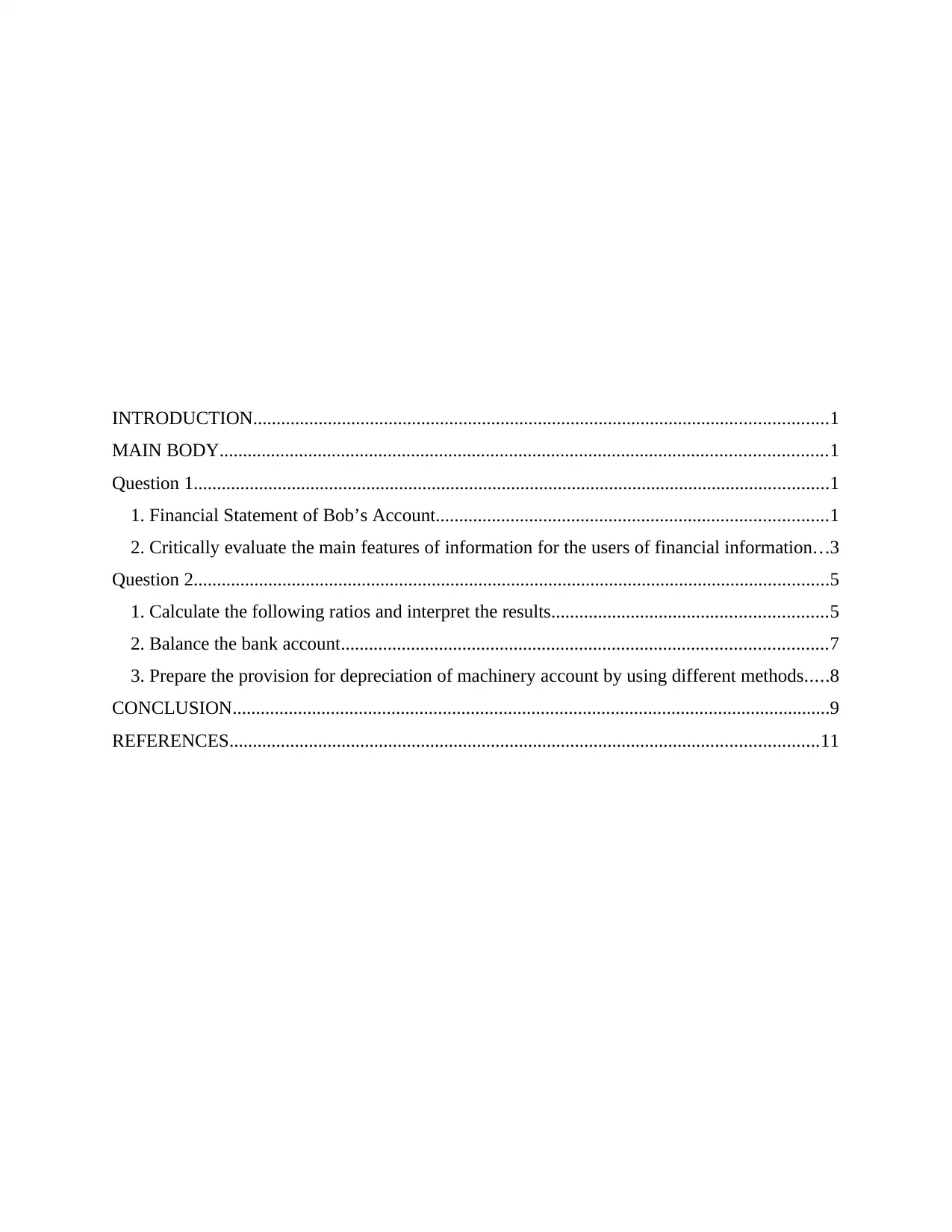
INTRODUCTION...........................................................................................................................1
MAIN BODY..................................................................................................................................1
Question 1........................................................................................................................................1
1. Financial Statement of Bob’s Account....................................................................................1
2. Critically evaluate the main features of information for the users of financial information...3
Question 2........................................................................................................................................5
1. Calculate the following ratios and interpret the results...........................................................5
2. Balance the bank account........................................................................................................7
3. Prepare the provision for depreciation of machinery account by using different methods.....8
CONCLUSION................................................................................................................................9
REFERENCES..............................................................................................................................11
MAIN BODY..................................................................................................................................1
Question 1........................................................................................................................................1
1. Financial Statement of Bob’s Account....................................................................................1
2. Critically evaluate the main features of information for the users of financial information...3
Question 2........................................................................................................................................5
1. Calculate the following ratios and interpret the results...........................................................5
2. Balance the bank account........................................................................................................7
3. Prepare the provision for depreciation of machinery account by using different methods.....8
CONCLUSION................................................................................................................................9
REFERENCES..............................................................................................................................11
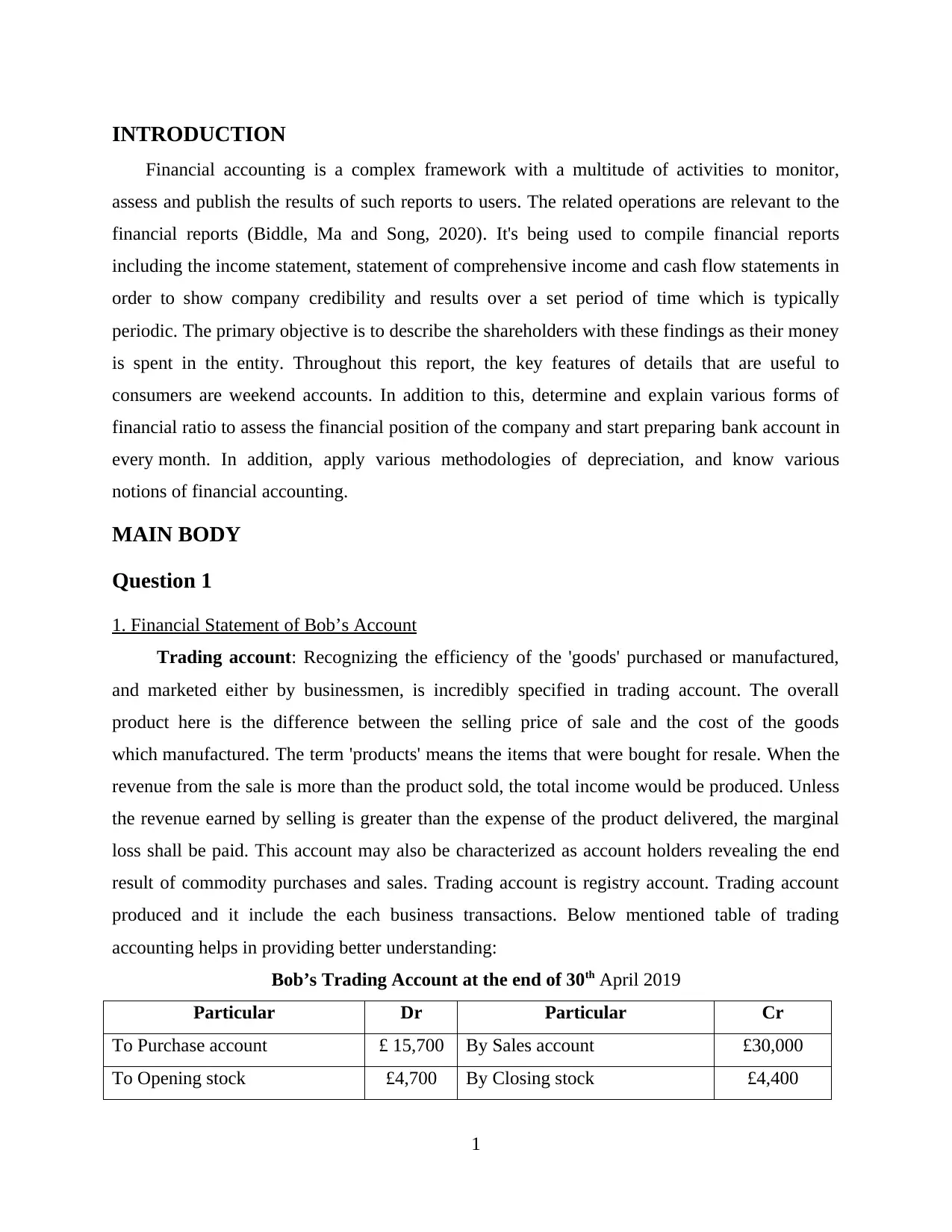
INTRODUCTION
Financial accounting is a complex framework with a multitude of activities to monitor,
assess and publish the results of such reports to users. The related operations are relevant to the
financial reports (Biddle, Ma and Song, 2020). It's being used to compile financial reports
including the income statement, statement of comprehensive income and cash flow statements in
order to show company credibility and results over a set period of time which is typically
periodic. The primary objective is to describe the shareholders with these findings as their money
is spent in the entity. Throughout this report, the key features of details that are useful to
consumers are weekend accounts. In addition to this, determine and explain various forms of
financial ratio to assess the financial position of the company and start preparing bank account in
every month. In addition, apply various methodologies of depreciation, and know various
notions of financial accounting.
MAIN BODY
Question 1
1. Financial Statement of Bob’s Account
Trading account: Recognizing the efficiency of the 'goods' purchased or manufactured,
and marketed either by businessmen, is incredibly specified in trading account. The overall
product here is the difference between the selling price of sale and the cost of the goods
which manufactured. The term 'products' means the items that were bought for resale. When the
revenue from the sale is more than the product sold, the total income would be produced. Unless
the revenue earned by selling is greater than the expense of the product delivered, the marginal
loss shall be paid. This account may also be characterized as account holders revealing the end
result of commodity purchases and sales. Trading account is registry account. Trading account
produced and it include the each business transactions. Below mentioned table of trading
accounting helps in providing better understanding:
Bob’s Trading Account at the end of 30th April 2019
Particular Dr Particular Cr
To Purchase account £ 15,700 By Sales account £30,000
To Opening stock £4,700 By Closing stock £4,400
1
Financial accounting is a complex framework with a multitude of activities to monitor,
assess and publish the results of such reports to users. The related operations are relevant to the
financial reports (Biddle, Ma and Song, 2020). It's being used to compile financial reports
including the income statement, statement of comprehensive income and cash flow statements in
order to show company credibility and results over a set period of time which is typically
periodic. The primary objective is to describe the shareholders with these findings as their money
is spent in the entity. Throughout this report, the key features of details that are useful to
consumers are weekend accounts. In addition to this, determine and explain various forms of
financial ratio to assess the financial position of the company and start preparing bank account in
every month. In addition, apply various methodologies of depreciation, and know various
notions of financial accounting.
MAIN BODY
Question 1
1. Financial Statement of Bob’s Account
Trading account: Recognizing the efficiency of the 'goods' purchased or manufactured,
and marketed either by businessmen, is incredibly specified in trading account. The overall
product here is the difference between the selling price of sale and the cost of the goods
which manufactured. The term 'products' means the items that were bought for resale. When the
revenue from the sale is more than the product sold, the total income would be produced. Unless
the revenue earned by selling is greater than the expense of the product delivered, the marginal
loss shall be paid. This account may also be characterized as account holders revealing the end
result of commodity purchases and sales. Trading account is registry account. Trading account
produced and it include the each business transactions. Below mentioned table of trading
accounting helps in providing better understanding:
Bob’s Trading Account at the end of 30th April 2019
Particular Dr Particular Cr
To Purchase account £ 15,700 By Sales account £30,000
To Opening stock £4,700 By Closing stock £4,400
1
⊘ This is a preview!⊘
Do you want full access?
Subscribe today to unlock all pages.

Trusted by 1+ million students worldwide
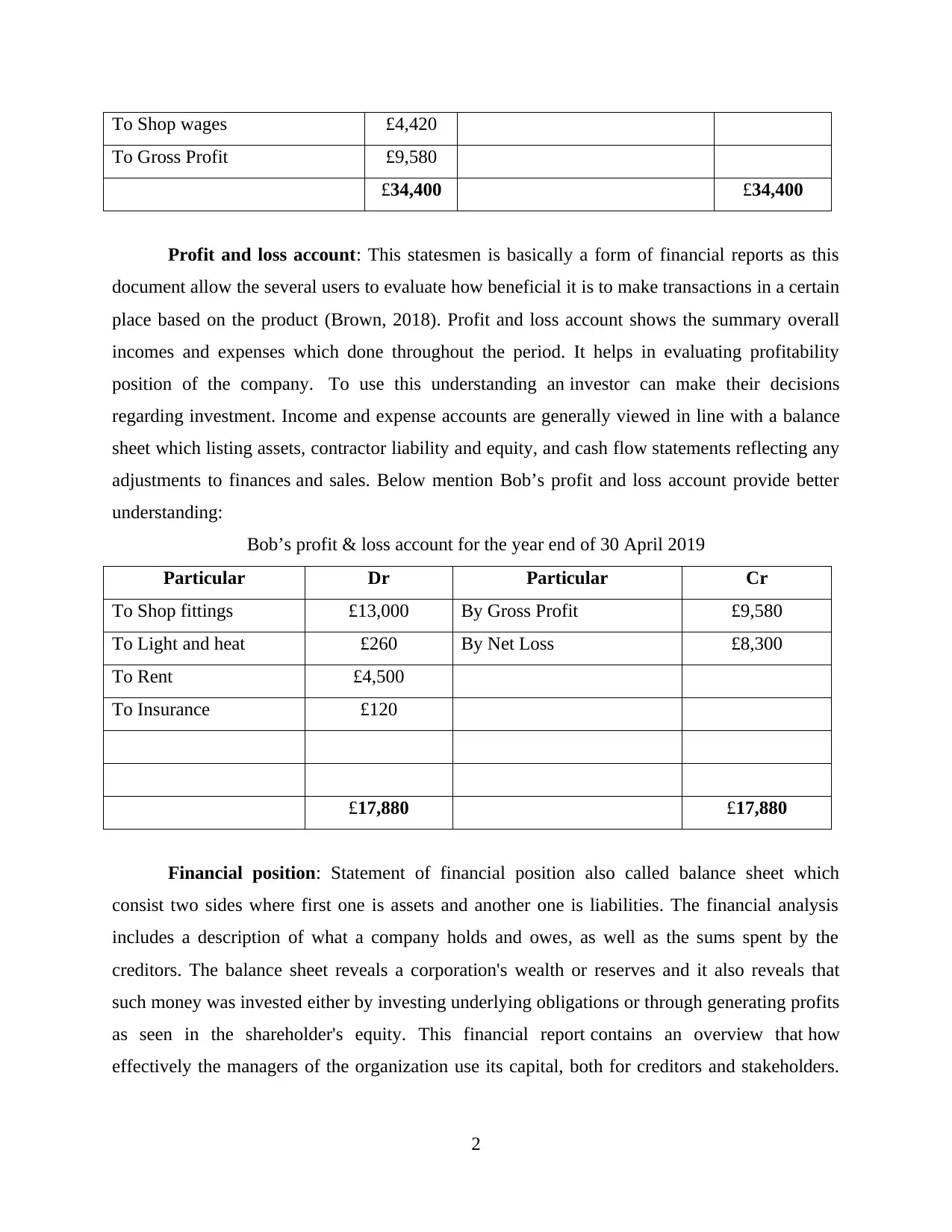
To Shop wages £4,420
To Gross Profit £9,580
£34,400 £34,400
Profit and loss account: This statesmen is basically a form of financial reports as this
document allow the several users to evaluate how beneficial it is to make transactions in a certain
place based on the product (Brown, 2018). Profit and loss account shows the summary overall
incomes and expenses which done throughout the period. It helps in evaluating profitability
position of the company. To use this understanding an investor can make their decisions
regarding investment. Income and expense accounts are generally viewed in line with a balance
sheet which listing assets, contractor liability and equity, and cash flow statements reflecting any
adjustments to finances and sales. Below mention Bob’s profit and loss account provide better
understanding:
Bob’s profit & loss account for the year end of 30 April 2019
Particular Dr Particular Cr
To Shop fittings £13,000 By Gross Profit £9,580
To Light and heat £260 By Net Loss £8,300
To Rent £4,500
To Insurance £120
£17,880 £17,880
Financial position: Statement of financial position also called balance sheet which
consist two sides where first one is assets and another one is liabilities. The financial analysis
includes a description of what a company holds and owes, as well as the sums spent by the
creditors. The balance sheet reveals a corporation's wealth or reserves and it also reveals that
such money was invested either by investing underlying obligations or through generating profits
as seen in the shareholder's equity. This financial report contains an overview that how
effectively the managers of the organization use its capital, both for creditors and stakeholders.
2
To Gross Profit £9,580
£34,400 £34,400
Profit and loss account: This statesmen is basically a form of financial reports as this
document allow the several users to evaluate how beneficial it is to make transactions in a certain
place based on the product (Brown, 2018). Profit and loss account shows the summary overall
incomes and expenses which done throughout the period. It helps in evaluating profitability
position of the company. To use this understanding an investor can make their decisions
regarding investment. Income and expense accounts are generally viewed in line with a balance
sheet which listing assets, contractor liability and equity, and cash flow statements reflecting any
adjustments to finances and sales. Below mention Bob’s profit and loss account provide better
understanding:
Bob’s profit & loss account for the year end of 30 April 2019
Particular Dr Particular Cr
To Shop fittings £13,000 By Gross Profit £9,580
To Light and heat £260 By Net Loss £8,300
To Rent £4,500
To Insurance £120
£17,880 £17,880
Financial position: Statement of financial position also called balance sheet which
consist two sides where first one is assets and another one is liabilities. The financial analysis
includes a description of what a company holds and owes, as well as the sums spent by the
creditors. The balance sheet reveals a corporation's wealth or reserves and it also reveals that
such money was invested either by investing underlying obligations or through generating profits
as seen in the shareholder's equity. This financial report contains an overview that how
effectively the managers of the organization use its capital, both for creditors and stakeholders.
2
Paraphrase This Document
Need a fresh take? Get an instant paraphrase of this document with our AI Paraphraser
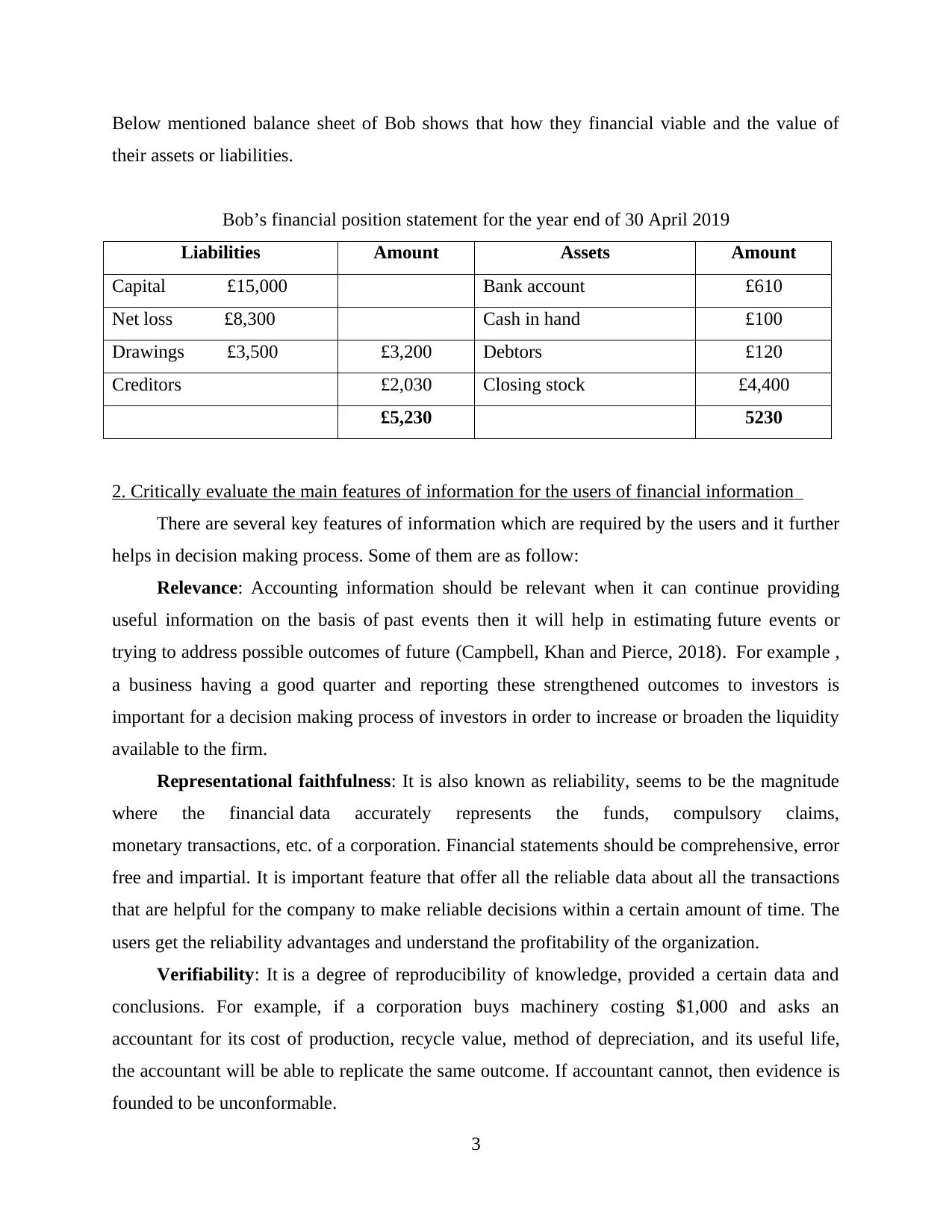
Below mentioned balance sheet of Bob shows that how they financial viable and the value of
their assets or liabilities.
Bob’s financial position statement for the year end of 30 April 2019
Liabilities Amount Assets Amount
Capital £15,000 Bank account £610
Net loss £8,300 Cash in hand £100
Drawings £3,500 £3,200 Debtors £120
Creditors £2,030 Closing stock £4,400
£5,230 5230
2. Critically evaluate the main features of information for the users of financial information
There are several key features of information which are required by the users and it further
helps in decision making process. Some of them are as follow:
Relevance: Accounting information should be relevant when it can continue providing
useful information on the basis of past events then it will help in estimating future events or
trying to address possible outcomes of future (Campbell, Khan and Pierce, 2018). For example ,
a business having a good quarter and reporting these strengthened outcomes to investors is
important for a decision making process of investors in order to increase or broaden the liquidity
available to the firm.
Representational faithfulness: It is also known as reliability, seems to be the magnitude
where the financial data accurately represents the funds, compulsory claims,
monetary transactions, etc. of a corporation. Financial statements should be comprehensive, error
free and impartial. It is important feature that offer all the reliable data about all the transactions
that are helpful for the company to make reliable decisions within a certain amount of time. The
users get the reliability advantages and understand the profitability of the organization.
Verifiability: It is a degree of reproducibility of knowledge, provided a certain data and
conclusions. For example, if a corporation buys machinery costing $1,000 and asks an
accountant for its cost of production, recycle value, method of depreciation, and its useful life,
the accountant will be able to replicate the same outcome. If accountant cannot, then evidence is
founded to be unconformable.
3
their assets or liabilities.
Bob’s financial position statement for the year end of 30 April 2019
Liabilities Amount Assets Amount
Capital £15,000 Bank account £610
Net loss £8,300 Cash in hand £100
Drawings £3,500 £3,200 Debtors £120
Creditors £2,030 Closing stock £4,400
£5,230 5230
2. Critically evaluate the main features of information for the users of financial information
There are several key features of information which are required by the users and it further
helps in decision making process. Some of them are as follow:
Relevance: Accounting information should be relevant when it can continue providing
useful information on the basis of past events then it will help in estimating future events or
trying to address possible outcomes of future (Campbell, Khan and Pierce, 2018). For example ,
a business having a good quarter and reporting these strengthened outcomes to investors is
important for a decision making process of investors in order to increase or broaden the liquidity
available to the firm.
Representational faithfulness: It is also known as reliability, seems to be the magnitude
where the financial data accurately represents the funds, compulsory claims,
monetary transactions, etc. of a corporation. Financial statements should be comprehensive, error
free and impartial. It is important feature that offer all the reliable data about all the transactions
that are helpful for the company to make reliable decisions within a certain amount of time. The
users get the reliability advantages and understand the profitability of the organization.
Verifiability: It is a degree of reproducibility of knowledge, provided a certain data and
conclusions. For example, if a corporation buys machinery costing $1,000 and asks an
accountant for its cost of production, recycle value, method of depreciation, and its useful life,
the accountant will be able to replicate the same outcome. If accountant cannot, then evidence is
founded to be unconformable.
3
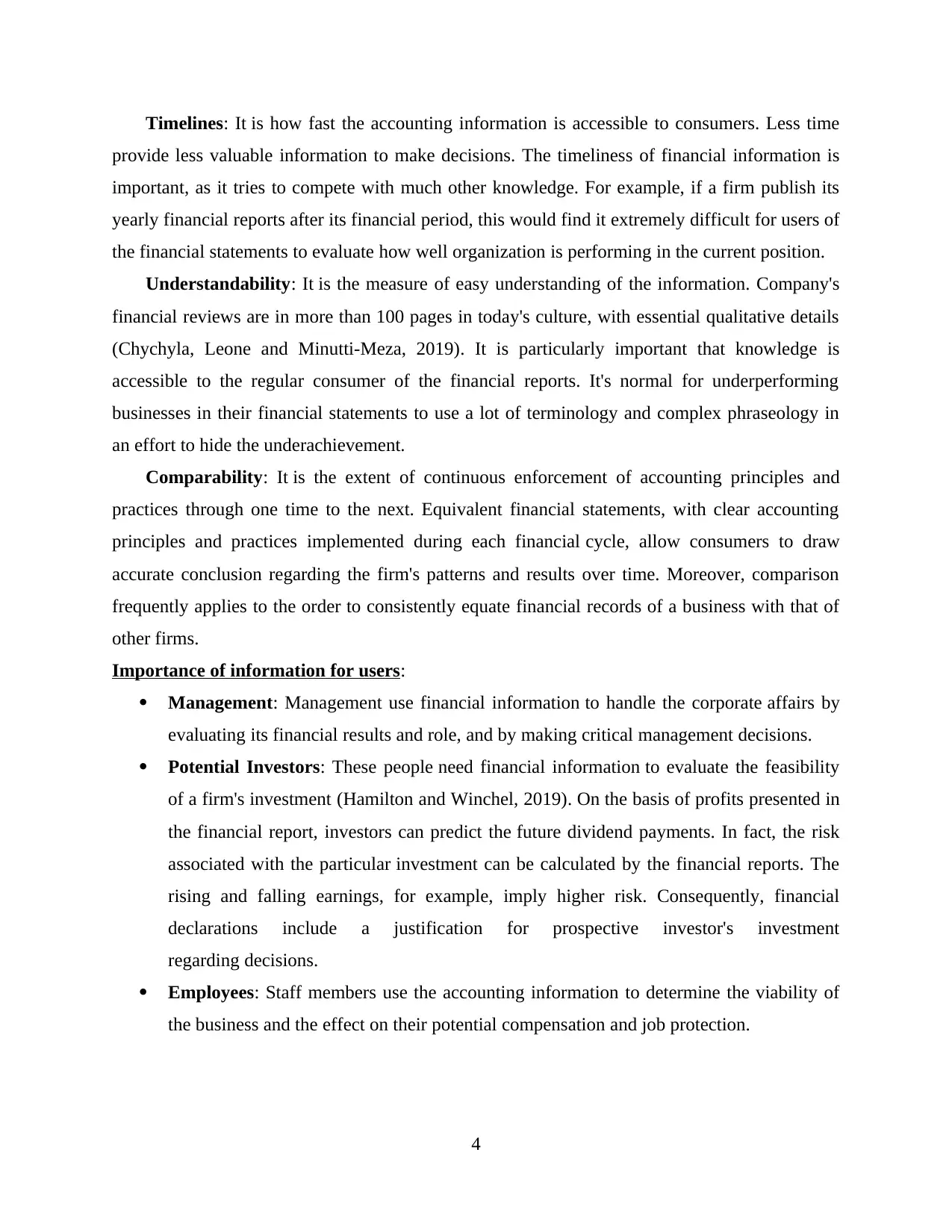
Timelines: It is how fast the accounting information is accessible to consumers. Less time
provide less valuable information to make decisions. The timeliness of financial information is
important, as it tries to compete with much other knowledge. For example, if a firm publish its
yearly financial reports after its financial period, this would find it extremely difficult for users of
the financial statements to evaluate how well organization is performing in the current position.
Understandability: It is the measure of easy understanding of the information. Company's
financial reviews are in more than 100 pages in today's culture, with essential qualitative details
(Chychyla, Leone and Minutti-Meza, 2019). It is particularly important that knowledge is
accessible to the regular consumer of the financial reports. It's normal for underperforming
businesses in their financial statements to use a lot of terminology and complex phraseology in
an effort to hide the underachievement.
Comparability: It is the extent of continuous enforcement of accounting principles and
practices through one time to the next. Equivalent financial statements, with clear accounting
principles and practices implemented during each financial cycle, allow consumers to draw
accurate conclusion regarding the firm's patterns and results over time. Moreover, comparison
frequently applies to the order to consistently equate financial records of a business with that of
other firms.
Importance of information for users:
Management: Management use financial information to handle the corporate affairs by
evaluating its financial results and role, and by making critical management decisions.
Potential Investors: These people need financial information to evaluate the feasibility
of a firm's investment (Hamilton and Winchel, 2019). On the basis of profits presented in
the financial report, investors can predict the future dividend payments. In fact, the risk
associated with the particular investment can be calculated by the financial reports. The
rising and falling earnings, for example, imply higher risk. Consequently, financial
declarations include a justification for prospective investor's investment
regarding decisions.
Employees: Staff members use the accounting information to determine the viability of
the business and the effect on their potential compensation and job protection.
4
provide less valuable information to make decisions. The timeliness of financial information is
important, as it tries to compete with much other knowledge. For example, if a firm publish its
yearly financial reports after its financial period, this would find it extremely difficult for users of
the financial statements to evaluate how well organization is performing in the current position.
Understandability: It is the measure of easy understanding of the information. Company's
financial reviews are in more than 100 pages in today's culture, with essential qualitative details
(Chychyla, Leone and Minutti-Meza, 2019). It is particularly important that knowledge is
accessible to the regular consumer of the financial reports. It's normal for underperforming
businesses in their financial statements to use a lot of terminology and complex phraseology in
an effort to hide the underachievement.
Comparability: It is the extent of continuous enforcement of accounting principles and
practices through one time to the next. Equivalent financial statements, with clear accounting
principles and practices implemented during each financial cycle, allow consumers to draw
accurate conclusion regarding the firm's patterns and results over time. Moreover, comparison
frequently applies to the order to consistently equate financial records of a business with that of
other firms.
Importance of information for users:
Management: Management use financial information to handle the corporate affairs by
evaluating its financial results and role, and by making critical management decisions.
Potential Investors: These people need financial information to evaluate the feasibility
of a firm's investment (Hamilton and Winchel, 2019). On the basis of profits presented in
the financial report, investors can predict the future dividend payments. In fact, the risk
associated with the particular investment can be calculated by the financial reports. The
rising and falling earnings, for example, imply higher risk. Consequently, financial
declarations include a justification for prospective investor's investment
regarding decisions.
Employees: Staff members use the accounting information to determine the viability of
the business and the effect on their potential compensation and job protection.
4
⊘ This is a preview!⊘
Do you want full access?
Subscribe today to unlock all pages.

Trusted by 1+ million students worldwide
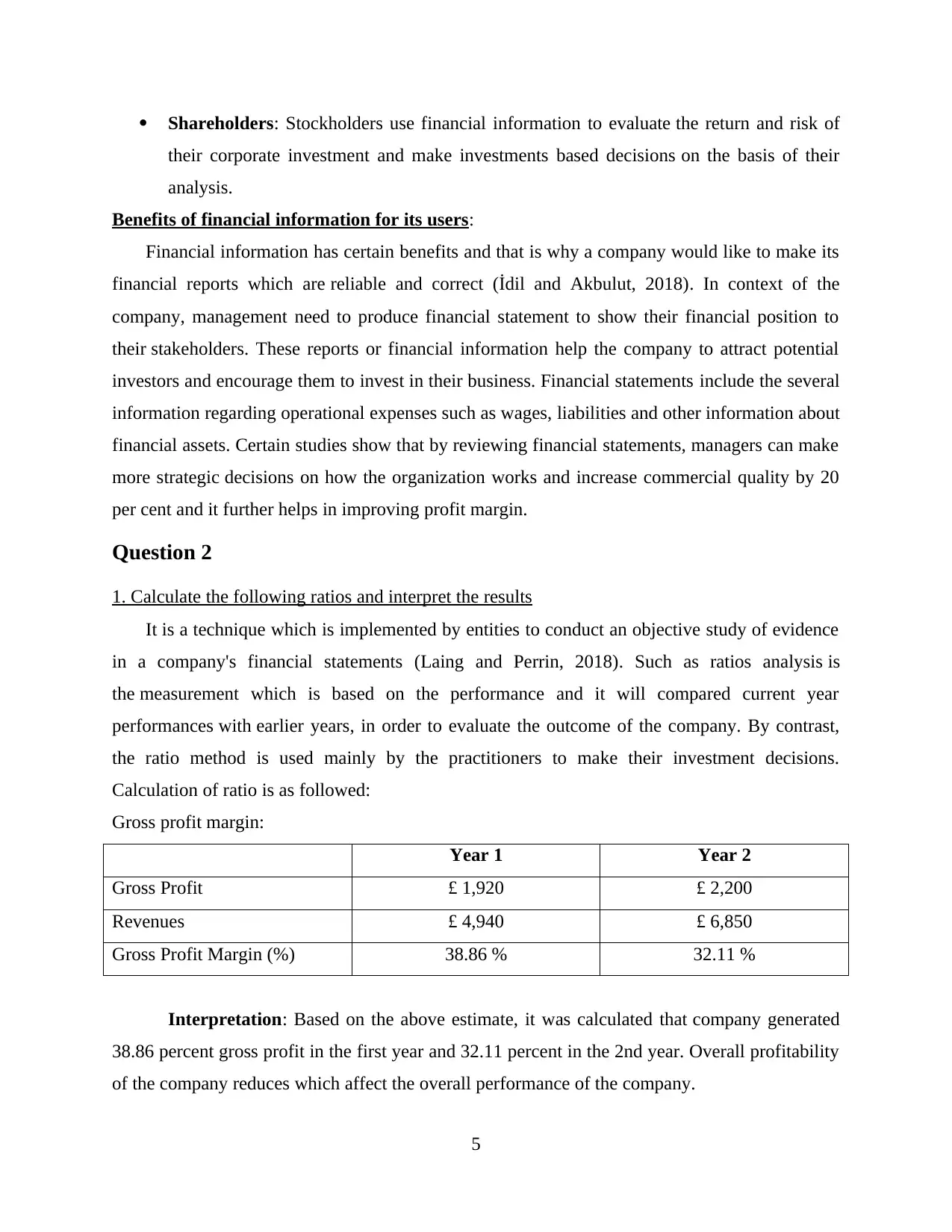
Shareholders: Stockholders use financial information to evaluate the return and risk of
their corporate investment and make investments based decisions on the basis of their
analysis.
Benefits of financial information for its users:
Financial information has certain benefits and that is why a company would like to make its
financial reports which are reliable and correct (İdil and Akbulut, 2018). In context of the
company, management need to produce financial statement to show their financial position to
their stakeholders. These reports or financial information help the company to attract potential
investors and encourage them to invest in their business. Financial statements include the several
information regarding operational expenses such as wages, liabilities and other information about
financial assets. Certain studies show that by reviewing financial statements, managers can make
more strategic decisions on how the organization works and increase commercial quality by 20
per cent and it further helps in improving profit margin.
Question 2
1. Calculate the following ratios and interpret the results
It is a technique which is implemented by entities to conduct an objective study of evidence
in a company's financial statements (Laing and Perrin, 2018). Such as ratios analysis is
the measurement which is based on the performance and it will compared current year
performances with earlier years, in order to evaluate the outcome of the company. By contrast,
the ratio method is used mainly by the practitioners to make their investment decisions.
Calculation of ratio is as followed:
Gross profit margin:
Year 1 Year 2
Gross Profit £ 1,920 £ 2,200
Revenues £ 4,940 £ 6,850
Gross Profit Margin (%) 38.86 % 32.11 %
Interpretation: Based on the above estimate, it was calculated that company generated
38.86 percent gross profit in the first year and 32.11 percent in the 2nd year. Overall profitability
of the company reduces which affect the overall performance of the company.
5
their corporate investment and make investments based decisions on the basis of their
analysis.
Benefits of financial information for its users:
Financial information has certain benefits and that is why a company would like to make its
financial reports which are reliable and correct (İdil and Akbulut, 2018). In context of the
company, management need to produce financial statement to show their financial position to
their stakeholders. These reports or financial information help the company to attract potential
investors and encourage them to invest in their business. Financial statements include the several
information regarding operational expenses such as wages, liabilities and other information about
financial assets. Certain studies show that by reviewing financial statements, managers can make
more strategic decisions on how the organization works and increase commercial quality by 20
per cent and it further helps in improving profit margin.
Question 2
1. Calculate the following ratios and interpret the results
It is a technique which is implemented by entities to conduct an objective study of evidence
in a company's financial statements (Laing and Perrin, 2018). Such as ratios analysis is
the measurement which is based on the performance and it will compared current year
performances with earlier years, in order to evaluate the outcome of the company. By contrast,
the ratio method is used mainly by the practitioners to make their investment decisions.
Calculation of ratio is as followed:
Gross profit margin:
Year 1 Year 2
Gross Profit £ 1,920 £ 2,200
Revenues £ 4,940 £ 6,850
Gross Profit Margin (%) 38.86 % 32.11 %
Interpretation: Based on the above estimate, it was calculated that company generated
38.86 percent gross profit in the first year and 32.11 percent in the 2nd year. Overall profitability
of the company reduces which affect the overall performance of the company.
5
Paraphrase This Document
Need a fresh take? Get an instant paraphrase of this document with our AI Paraphraser
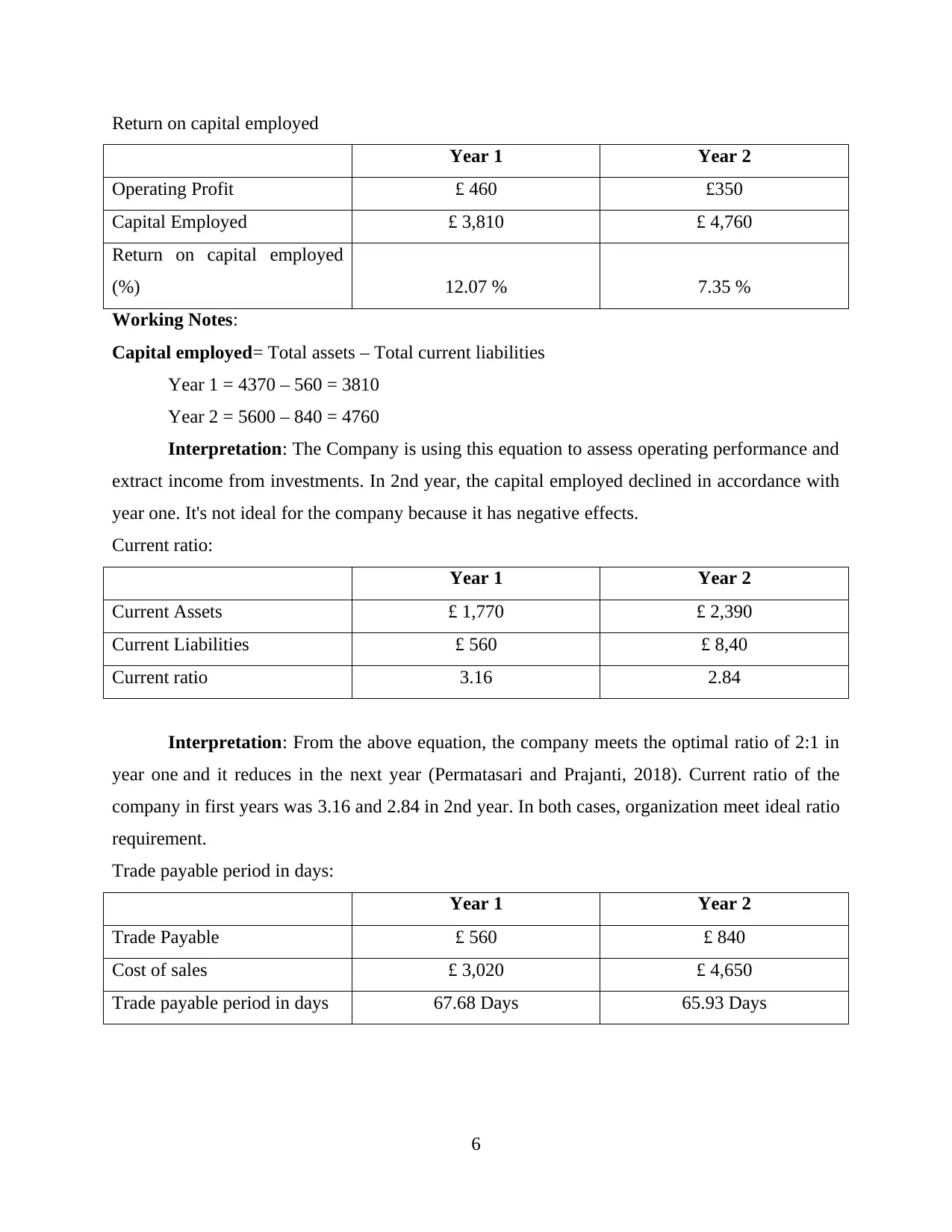
Return on capital employed
Year 1 Year 2
Operating Profit £ 460 £350
Capital Employed £ 3,810 £ 4,760
Return on capital employed
(%) 12.07 % 7.35 %
Working Notes:
Capital employed= Total assets – Total current liabilities
Year 1 = 4370 – 560 = 3810
Year 2 = 5600 – 840 = 4760
Interpretation: The Company is using this equation to assess operating performance and
extract income from investments. In 2nd year, the capital employed declined in accordance with
year one. It's not ideal for the company because it has negative effects.
Current ratio:
Year 1 Year 2
Current Assets £ 1,770 £ 2,390
Current Liabilities £ 560 £ 8,40
Current ratio 3.16 2.84
Interpretation: From the above equation, the company meets the optimal ratio of 2:1 in
year one and it reduces in the next year (Permatasari and Prajanti, 2018). Current ratio of the
company in first years was 3.16 and 2.84 in 2nd year. In both cases, organization meet ideal ratio
requirement.
Trade payable period in days:
Year 1 Year 2
Trade Payable £ 560 £ 840
Cost of sales £ 3,020 £ 4,650
Trade payable period in days 67.68 Days 65.93 Days
6
Year 1 Year 2
Operating Profit £ 460 £350
Capital Employed £ 3,810 £ 4,760
Return on capital employed
(%) 12.07 % 7.35 %
Working Notes:
Capital employed= Total assets – Total current liabilities
Year 1 = 4370 – 560 = 3810
Year 2 = 5600 – 840 = 4760
Interpretation: The Company is using this equation to assess operating performance and
extract income from investments. In 2nd year, the capital employed declined in accordance with
year one. It's not ideal for the company because it has negative effects.
Current ratio:
Year 1 Year 2
Current Assets £ 1,770 £ 2,390
Current Liabilities £ 560 £ 8,40
Current ratio 3.16 2.84
Interpretation: From the above equation, the company meets the optimal ratio of 2:1 in
year one and it reduces in the next year (Permatasari and Prajanti, 2018). Current ratio of the
company in first years was 3.16 and 2.84 in 2nd year. In both cases, organization meet ideal ratio
requirement.
Trade payable period in days:
Year 1 Year 2
Trade Payable £ 560 £ 840
Cost of sales £ 3,020 £ 4,650
Trade payable period in days 67.68 Days 65.93 Days
6
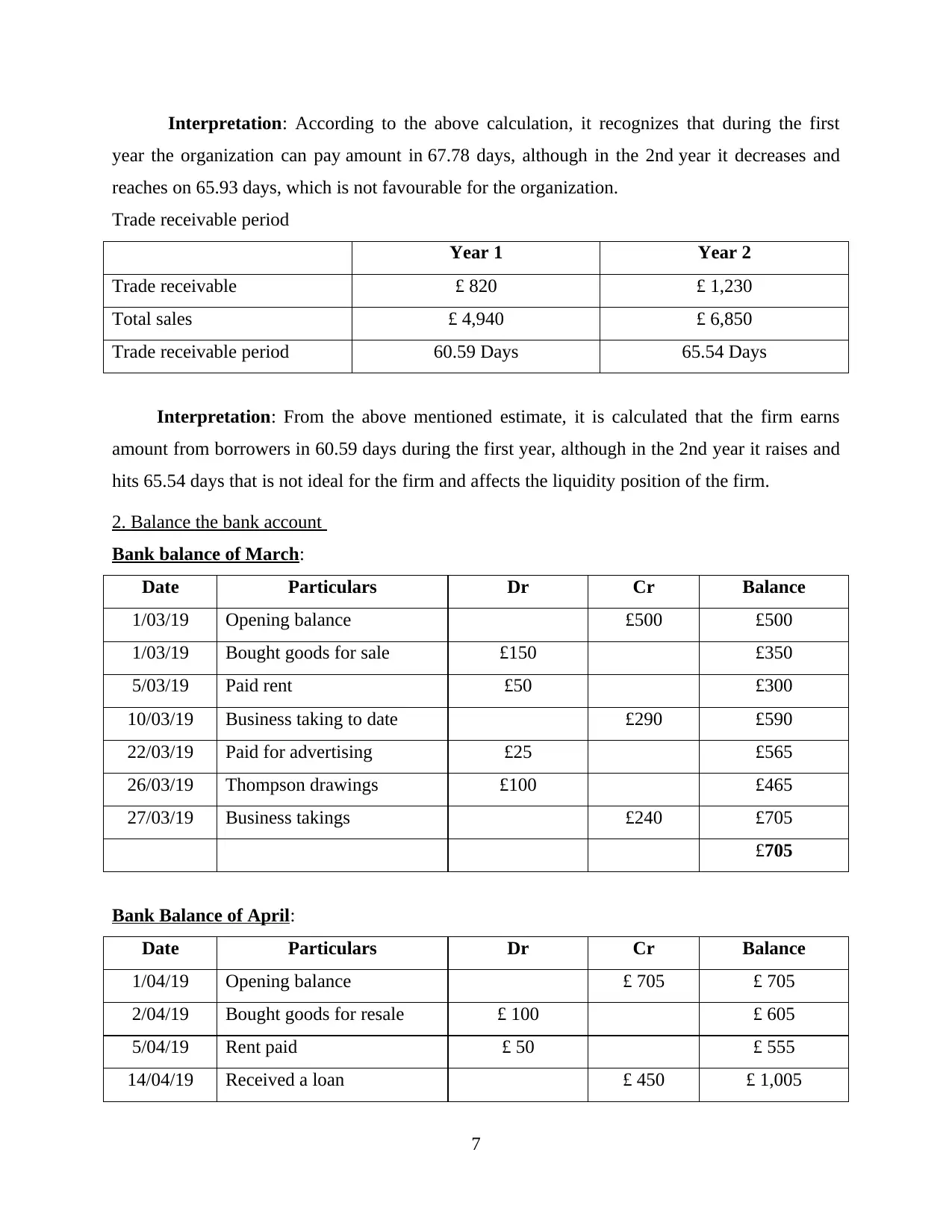
Interpretation: According to the above calculation, it recognizes that during the first
year the organization can pay amount in 67.78 days, although in the 2nd year it decreases and
reaches on 65.93 days, which is not favourable for the organization.
Trade receivable period
Year 1 Year 2
Trade receivable £ 820 £ 1,230
Total sales £ 4,940 £ 6,850
Trade receivable period 60.59 Days 65.54 Days
Interpretation: From the above mentioned estimate, it is calculated that the firm earns
amount from borrowers in 60.59 days during the first year, although in the 2nd year it raises and
hits 65.54 days that is not ideal for the firm and affects the liquidity position of the firm.
2. Balance the bank account
Bank balance of March:
Date Particulars Dr Cr Balance
1/03/19 Opening balance £500 £500
1/03/19 Bought goods for sale £150 £350
5/03/19 Paid rent £50 £300
10/03/19 Business taking to date £290 £590
22/03/19 Paid for advertising £25 £565
26/03/19 Thompson drawings £100 £465
27/03/19 Business takings £240 £705
£705
Bank Balance of April:
Date Particulars Dr Cr Balance
1/04/19 Opening balance £ 705 £ 705
2/04/19 Bought goods for resale £ 100 £ 605
5/04/19 Rent paid £ 50 £ 555
14/04/19 Received a loan £ 450 £ 1,005
7
year the organization can pay amount in 67.78 days, although in the 2nd year it decreases and
reaches on 65.93 days, which is not favourable for the organization.
Trade receivable period
Year 1 Year 2
Trade receivable £ 820 £ 1,230
Total sales £ 4,940 £ 6,850
Trade receivable period 60.59 Days 65.54 Days
Interpretation: From the above mentioned estimate, it is calculated that the firm earns
amount from borrowers in 60.59 days during the first year, although in the 2nd year it raises and
hits 65.54 days that is not ideal for the firm and affects the liquidity position of the firm.
2. Balance the bank account
Bank balance of March:
Date Particulars Dr Cr Balance
1/03/19 Opening balance £500 £500
1/03/19 Bought goods for sale £150 £350
5/03/19 Paid rent £50 £300
10/03/19 Business taking to date £290 £590
22/03/19 Paid for advertising £25 £565
26/03/19 Thompson drawings £100 £465
27/03/19 Business takings £240 £705
£705
Bank Balance of April:
Date Particulars Dr Cr Balance
1/04/19 Opening balance £ 705 £ 705
2/04/19 Bought goods for resale £ 100 £ 605
5/04/19 Rent paid £ 50 £ 555
14/04/19 Received a loan £ 450 £ 1,005
7
⊘ This is a preview!⊘
Do you want full access?
Subscribe today to unlock all pages.

Trusted by 1+ million students worldwide
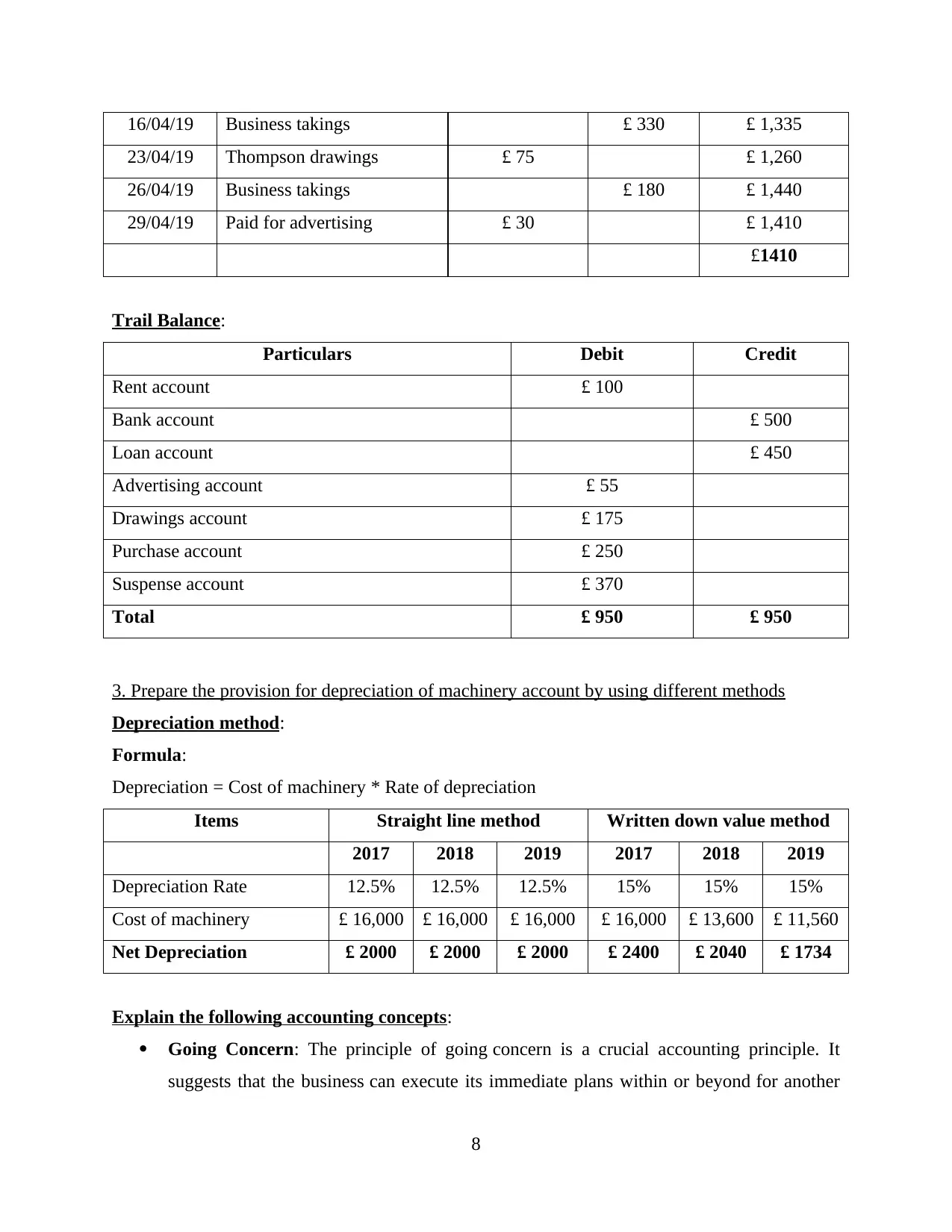
16/04/19 Business takings £ 330 £ 1,335
23/04/19 Thompson drawings £ 75 £ 1,260
26/04/19 Business takings £ 180 £ 1,440
29/04/19 Paid for advertising £ 30 £ 1,410
£1410
Trail Balance:
Particulars Debit Credit
Rent account £ 100
Bank account £ 500
Loan account £ 450
Advertising account £ 55
Drawings account £ 175
Purchase account £ 250
Suspense account £ 370
Total £ 950 £ 950
3. Prepare the provision for depreciation of machinery account by using different methods
Depreciation method:
Formula:
Depreciation = Cost of machinery * Rate of depreciation
Items Straight line method Written down value method
2017 2018 2019 2017 2018 2019
Depreciation Rate 12.5% 12.5% 12.5% 15% 15% 15%
Cost of machinery £ 16,000 £ 16,000 £ 16,000 £ 16,000 £ 13,600 £ 11,560
Net Depreciation £ 2000 £ 2000 £ 2000 £ 2400 £ 2040 £ 1734
Explain the following accounting concepts:
Going Concern: The principle of going concern is a crucial accounting principle. It
suggests that the business can execute its immediate plans within or beyond for another
8
23/04/19 Thompson drawings £ 75 £ 1,260
26/04/19 Business takings £ 180 £ 1,440
29/04/19 Paid for advertising £ 30 £ 1,410
£1410
Trail Balance:
Particulars Debit Credit
Rent account £ 100
Bank account £ 500
Loan account £ 450
Advertising account £ 55
Drawings account £ 175
Purchase account £ 250
Suspense account £ 370
Total £ 950 £ 950
3. Prepare the provision for depreciation of machinery account by using different methods
Depreciation method:
Formula:
Depreciation = Cost of machinery * Rate of depreciation
Items Straight line method Written down value method
2017 2018 2019 2017 2018 2019
Depreciation Rate 12.5% 12.5% 12.5% 15% 15% 15%
Cost of machinery £ 16,000 £ 16,000 £ 16,000 £ 16,000 £ 13,600 £ 11,560
Net Depreciation £ 2000 £ 2000 £ 2000 £ 2400 £ 2040 £ 1734
Explain the following accounting concepts:
Going Concern: The principle of going concern is a crucial accounting principle. It
suggests that the business can execute its immediate plans within or beyond for another
8
Paraphrase This Document
Need a fresh take? Get an instant paraphrase of this document with our AI Paraphraser
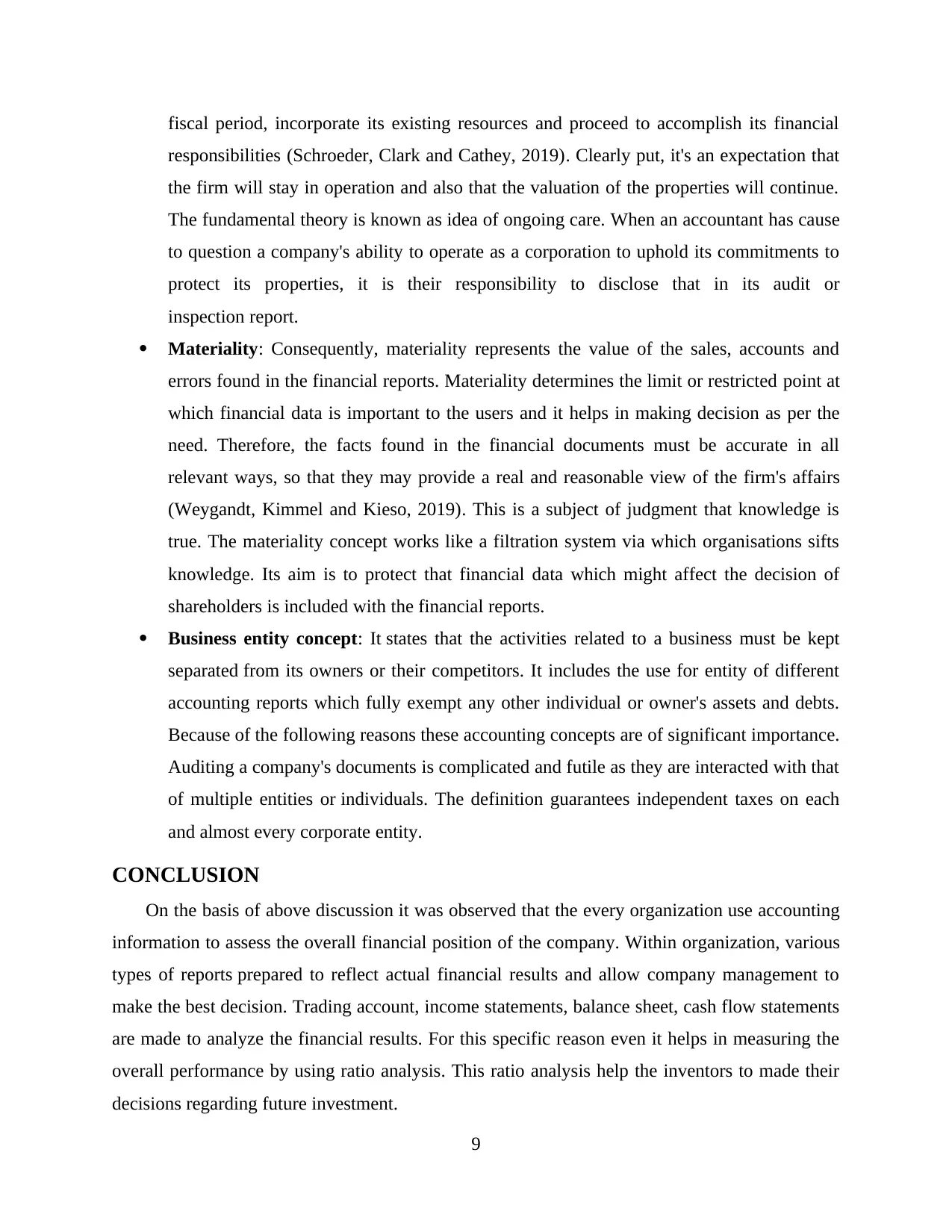
fiscal period, incorporate its existing resources and proceed to accomplish its financial
responsibilities (Schroeder, Clark and Cathey, 2019). Clearly put, it's an expectation that
the firm will stay in operation and also that the valuation of the properties will continue.
The fundamental theory is known as idea of ongoing care. When an accountant has cause
to question a company's ability to operate as a corporation to uphold its commitments to
protect its properties, it is their responsibility to disclose that in its audit or
inspection report.
Materiality: Consequently, materiality represents the value of the sales, accounts and
errors found in the financial reports. Materiality determines the limit or restricted point at
which financial data is important to the users and it helps in making decision as per the
need. Therefore, the facts found in the financial documents must be accurate in all
relevant ways, so that they may provide a real and reasonable view of the firm's affairs
(Weygandt, Kimmel and Kieso, 2019). This is a subject of judgment that knowledge is
true. The materiality concept works like a filtration system via which organisations sifts
knowledge. Its aim is to protect that financial data which might affect the decision of
shareholders is included with the financial reports.
Business entity concept: It states that the activities related to a business must be kept
separated from its owners or their competitors. It includes the use for entity of different
accounting reports which fully exempt any other individual or owner's assets and debts.
Because of the following reasons these accounting concepts are of significant importance.
Auditing a company's documents is complicated and futile as they are interacted with that
of multiple entities or individuals. The definition guarantees independent taxes on each
and almost every corporate entity.
CONCLUSION
On the basis of above discussion it was observed that the every organization use accounting
information to assess the overall financial position of the company. Within organization, various
types of reports prepared to reflect actual financial results and allow company management to
make the best decision. Trading account, income statements, balance sheet, cash flow statements
are made to analyze the financial results. For this specific reason even it helps in measuring the
overall performance by using ratio analysis. This ratio analysis help the inventors to made their
decisions regarding future investment.
9
responsibilities (Schroeder, Clark and Cathey, 2019). Clearly put, it's an expectation that
the firm will stay in operation and also that the valuation of the properties will continue.
The fundamental theory is known as idea of ongoing care. When an accountant has cause
to question a company's ability to operate as a corporation to uphold its commitments to
protect its properties, it is their responsibility to disclose that in its audit or
inspection report.
Materiality: Consequently, materiality represents the value of the sales, accounts and
errors found in the financial reports. Materiality determines the limit or restricted point at
which financial data is important to the users and it helps in making decision as per the
need. Therefore, the facts found in the financial documents must be accurate in all
relevant ways, so that they may provide a real and reasonable view of the firm's affairs
(Weygandt, Kimmel and Kieso, 2019). This is a subject of judgment that knowledge is
true. The materiality concept works like a filtration system via which organisations sifts
knowledge. Its aim is to protect that financial data which might affect the decision of
shareholders is included with the financial reports.
Business entity concept: It states that the activities related to a business must be kept
separated from its owners or their competitors. It includes the use for entity of different
accounting reports which fully exempt any other individual or owner's assets and debts.
Because of the following reasons these accounting concepts are of significant importance.
Auditing a company's documents is complicated and futile as they are interacted with that
of multiple entities or individuals. The definition guarantees independent taxes on each
and almost every corporate entity.
CONCLUSION
On the basis of above discussion it was observed that the every organization use accounting
information to assess the overall financial position of the company. Within organization, various
types of reports prepared to reflect actual financial results and allow company management to
make the best decision. Trading account, income statements, balance sheet, cash flow statements
are made to analyze the financial results. For this specific reason even it helps in measuring the
overall performance by using ratio analysis. This ratio analysis help the inventors to made their
decisions regarding future investment.
9

10
⊘ This is a preview!⊘
Do you want full access?
Subscribe today to unlock all pages.

Trusted by 1+ million students worldwide
1 out of 13
Related Documents
Your All-in-One AI-Powered Toolkit for Academic Success.
+13062052269
info@desklib.com
Available 24*7 on WhatsApp / Email
![[object Object]](/_next/static/media/star-bottom.7253800d.svg)
Unlock your academic potential
Copyright © 2020–2025 A2Z Services. All Rights Reserved. Developed and managed by ZUCOL.





